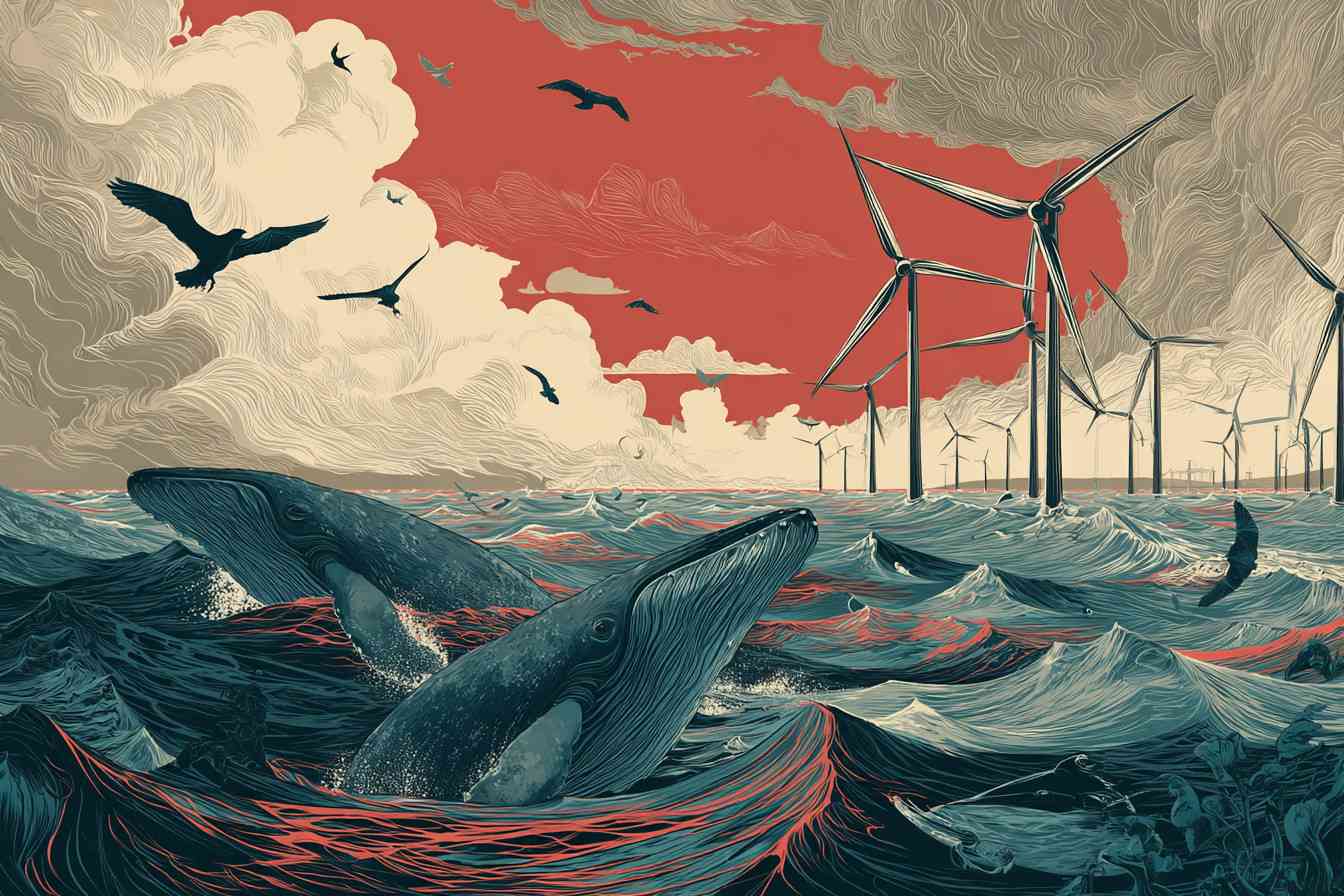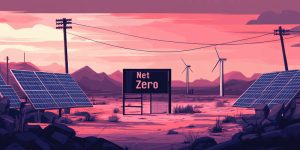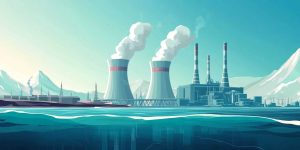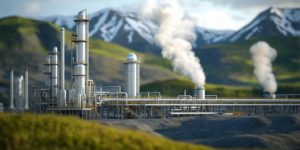The polluting and destructive impact of offshore wind farms

The promise of green energy is enticing: a clean future, less CO₂ emissions, and independence from fossil fuels. But behind the polished façade of so-called sustainable wind energy lies a harsh reality. Offshore wind farms, often presented as a miracle cure for climate change, in fact cause significant ecological harm to marine life, ecosystems, and even to the climate they are supposed to protect. The destructive impact of these installations is rarely acknowledged, partly because the financial and political interests of governments and large corporations are too great to allow an honest debate.
The industrial colonization of the sea
Where the oceans were once free from large-scale human infrastructure, they are now rapidly being transformed into industrial zones. European waters are at the heart of this transformation. In the North Sea alone, thousands of turbines are planned or under construction, with structures anchored as deep as a hundred meters into the seabed. The process resembles mining more than environmental stewardship.
Building these wind farms requires enormous quantities of steel, concrete, and copper. A single 12-megawatt turbine requires more than 2, 000 tons of steel and 500 tons of concrete (Environmental impacts of offshore wind farms, Marine Pollution Bulletin). The production of these materials generates massive CO₂ emissions, while the extraction of raw materials such as copper, nickel, and rare earth elements often causes environmental destruction in countries like Congo and China (The dark side of green energy, The Guardian).
Entire sea regions are closed off to fishermen and recreational users. In practice, offshore wind farms become exclusive industrial zones, where commercial exploitation is justified under the guise of sustainability. The sea is no longer a natural habitat but an energy plant.
Noise pollution and the destruction of marine life
The construction of offshore turbines generates extreme noise. Pile driving, the process of hammering foundations into the seabed, produces sound levels exceeding 200 decibels, traveling for many kilometers. For many marine species, such as porpoises and whales, this is fatal or causes permanent hearing damage and disorientation (Impact of underwater noise from offshore wind farm construction on marine mammals, Marine Ecology Progress Series).
During construction of Germany’s Borkum Riffgrund II wind farm, researchers observed that porpoises completely abandoned the area and did not return for months. Many never return at all, becoming stranded due to the disruption of their echolocation.
Even after the construction phase, wind farms continue to produce constant noise. Rotating blades and vibrating foundations emit low-frequency sounds that travel through the water. This “low-frequency noise” disrupts the orientation and communication of fish, particularly species like cod and herring that rely on sound (Subsea noise and its effects on fish, ICES Journal of Marine Science).
The result is a permanent disturbance of marine ecosystems that persists as long as the turbines stand.
The deadly toll on birds and bats
Above the surface, the toll is just as severe. Every year, hundreds of thousands of birds are killed by colliding with turbine blades, both on land and at sea. Seabirds such as gannets, gulls, and terns are especially affected.
Studies in Scotland show that some seabird populations near offshore wind farms have declined by as much as 80% (Collision risk of seabirds in offshore wind farms, Scottish Natural Heritage). Such figures are rarely cited in government reports, which are often based on theoretical models rather than actual counts.
Bats also suffer massive mortality due to pressure changes caused by the rotating blades, a phenomenon known as “barotrauma.” Even at sea, where bats are rarely found, carcasses have been discovered around turbines, attracted by insects that gather in the warm air currents of the blades (Bat mortality at wind farms: causes and consequences, Biological Conservation).
The wind industry calls this “collateral damage, ” but for endangered species, it means extinction.
Damage to the seabed and water quality
The construction of turbines also disrupts the seabed itself. Pile driving and drilling release sediments that spread over large areas, leading to murky water and oxygen-deprived zones. These conditions suffocate bottom-dwelling organisms such as mussels, worms, and shellfish that form the foundation of marine food webs (Sediment dispersion and ecological effects of offshore wind construction, Journal of Marine Systems).
Furthermore, many turbine coatings and cables contain toxic materials. The protective layers often include bisphenols and microplastics that slowly leach into the water, accumulating in plankton and fish, eventually entering the human food chain (Pollution from offshore wind farm materials, Environmental Science & Technology).
The installation of thousands of kilometers of electric cables also generates electromagnetic fields that interfere with the migration of fish and sea turtles. Species that navigate using the Earth’s magnetic field, such as eels and sharks, become disoriented (Electromagnetic fields and marine fauna, Marine Environmental Research).
The paradox of green energy
Wind energy is marketed as clean and sustainable, but its full lifecycle tells a different story. The construction, maintenance, and decommissioning of wind turbines rely heavily on fossil fuels. Installation vessels burn tens of thousands of liters of diesel daily. Transporting the massive turbine components, often produced in China or Korea, adds further emissions.
Moreover, wind farms must be dismantled or replaced after about 20 to 25 years. The recycling of turbine blades is a major environmental problem: they are made of glass fiber and epoxy composites that are nearly impossible to recycle. Millions of tons of blades now end up in landfills (Wind turbine blade waste in the circular economy, Waste Management).
At sea, dismantling is even more complex and expensive. Many companies lobby for leaving parts of the foundation buried in the seabed, a form of permanent pollution that remains largely unregulated.
Economic interests and political hypocrisy
The offshore wind industry is not driven by environmental awareness but by subsidies and political opportunism. European governments pour billions into so-called green projects, while the profits flow mainly to energy corporations and investment funds.
The European Investment Bank and national governments guarantee loans, meaning private companies take little to no risk. Wind farms are branded as “sustainable, ” but their business model depends entirely on public funding. Without subsidies and tax exemptions, no offshore wind project would be profitable (Subsidising the wind industry: hidden costs of green energy, Energy Policy).
Meanwhile, criticism of the environmental impact is often dismissed or censored. Those who question wind energy are quickly labeled “climate deniers.” This moral blackmail keeps the industry politically untouchable. The green lobby has become one of the most powerful networks in Europe, uniting environmental NGOs, corporations, and governments in selling the illusion of sustainability.
Military and geopolitical risks
Beyond ecological and economic damage, offshore wind farms pose security risks. Many are located in strategic sea zones and can interfere with navigation and radar systems. According to a report by the UK Defence Committee, wind farms in the North Sea are potential targets for sabotage and espionage (Defence implications of offshore infrastructure, UK Parliament).
There is growing concern that foreign actors, including China and Russia, are interested in the data and cable networks running through these installations. The notion that the energy transition brings independence is contradicted by Europe’s deep reliance on foreign technology and raw materials.
The illusion of energy neutrality
Wind farms produce energy, but far less than claimed. Their output is intermittent, dependent on weather, and requires constant backup from conventional power plants. This “dual infrastructure” drastically reduces the actual CO₂ savings (Intermittency of renewables and energy storage challenges, Energy Economics).
Turbines also lose efficiency as they age. After ten years, output can decline by 20 to 30 percent due to wear and erosion (Offshore wind turbine degradation and performance decline, Renewable Energy Journal). This means that the real energy benefit decreases over time, while the ecological damage remains constant.
A threat to marine biodiversity
The North Sea, once one of the richest marine ecosystems in the world, is slowly turning into an industrial landscape. Fishermen report declining fish stocks near wind farms, while currents and sediment patterns shift, altering entire ecosystems. Some species disappear, while others, like jellyfish and mussels, thrive on the artificial structures, leading to reduced biodiversity rather than more (Changes in marine biodiversity associated with offshore wind farms, Nature Ecology & Evolution).
Supporters claim these turbine foundations act as “artificial reefs, ” but in reality they replace complex natural systems with monotonous, man-made habitats. The result is ecological impoverishment that will only become fully visible over time.
The path forward: honesty about sustainability
True sustainability does not mean shifting pollution from one ecosystem to another. Nor does it mean blindly believing in technologies that cause more harm than they prevent. The future of energy should lie not in industrializing the oceans, but in reducing overconsumption and restoring balance between humanity and nature.
Offshore wind farms are not a solution, but a symptom of an economic system that calls itself “green” while depleting the planet even further. What is sold as a green revolution is, in truth, a new form of exploitation, this time not of oil fields, but of the sea itself.


















